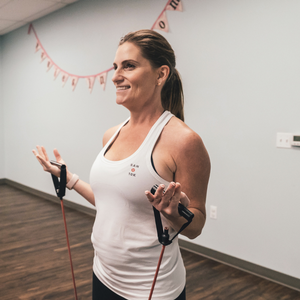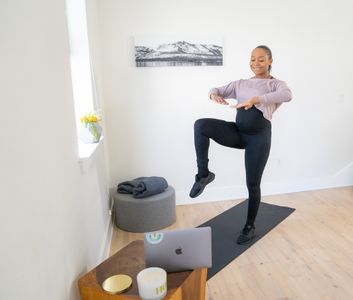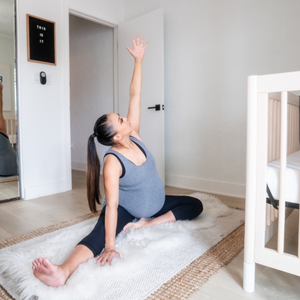
Body Scans and Pregnancy: What Every Mom-to-Be Should Do
FIT4MOM x Jessica Maurer
Pregnancy is a transformative journey filled with unique experiences, challenges, and joys. One key aspect of this journey is the ever-changing nature of the pregnant body. As your baby grows and develops, each day brings new physical changes that can significantly impact emotional and physical feelings, especially when engaging in fitness activities.
The journey of pregnancy is not just about preparing for childbirth; it's about nurturing physical and mental health to ensure a smooth transition into motherhood. This involves embracing the fluctuations in energy levels, comfort, and emotional states that come with each passing day. By incorporating self-awareness practices such as body scans and mindful movement, we can cultivate a deeper connection with the body and foster a positive mindset towards fitness during this transformative period.
Every pregnancy is different, and so are the daily experiences accompanying it. The body experiences many changes throughout each trimester, from hormonal shifts to physical discomforts such as nausea, fatigue, or balance changes. These variations can affect energy levels, mood, and overall well-being, making it crucial to approach fitness with mindfulness and self-awareness.
For example, a pregnant woman may feel fired up and ready for a great cardio workout on Monday, but her energy levels on Wednesday may require restorative yoga instead of the scheduled cardio class. Fitness during pregnancy should be flexible and adaptable. Consider our Prenatal and Postnatal Fitness Certification if you want to learn more.
Before starting a fitness practice (or start your day!), pregnant moms should perform a body scan. This involves paying attention to how they feel emotionally and physically. They should notice any tension, discomfort, or changes in energy levels. Doing so gives them valuable insights into their body's needs and limitations on that particular day.
Anyone can incorporate this simple 6-step Body Scan before starting their fitness practice for the day. Whether you are a prenatal fitness specialist or a pregnant woman, try these steps before starting your next session. If you are working with a coach, convey any noticed issues with them before engaging in movement.
START WITH THE BREATH
Start by closing your eyes gently and taking a few deep breaths. Inhale deeply through your nose, feeling your abdomen, ribs, and back expand. Exhale slowly through your mouth, releasing any tension. Your breath should become slow and steady, grounding you in the present moment.
FEET FIRST
Begin the body scan by focusing on your feet. Experiment with evening out the weight between your feet—front to back and side to side. During pregnancy, women may experience changes in their feet due to hormonal fluctuations, weight gain, and increased pressure on the lower extremities. As the body adjusts to the changes in weight and posture during pregnancy, some women may experience alterations in their gait or walking patterns. This can change how the feet strike the ground, potentially leading to additional stress on specific areas of the feet and lower limbs.
If you feel pain or discomfort here, you may need to limit the amount of quick reaction movements such as speed and agility drills - especially if moving laterally.
LEGS AND HIPS
Now, notice the weight of your legs and their position. Become aware of any tension, heaviness, or lightness in this area. Gently bend your knees so they are soft and not locked. Then, sway your hips side to side, front to back, and find your center of gravity with your hips directly over your heels and your tailbone relaxed. (PS That should feel good, so feel free to explore those sways as long as you want!)
If you notice joint pain during this step, you may need to choose lower-impact movements for the workout. Change your jumps to leaps or steps.
TORSO & POSTURE
Next, the focus should move to the belly and chest, paying attention to the rhythm of the breath as it moves in and out of the body. Pay attention to any sensations in your belly, such as stretching, tightness, or relaxation. Notice the position of your arms and the sensations in your shoulders. Slowly roll your shoulders back and down and find your ribs stacked over your hips with your shoulders on top of your ribs.
If you feel sharp pains in your abdominal area or a decrease in fetal movement, please contact your medical provider. Do you know about Maternal Warning Signs? Please learn about those here.
HEAD
Finally, focus on your neck and head. Notice any sensations in your neck, such as stiffness. Find a release for your facial muscles that may be experiencing tension. Encourage the crown of your head to lift towards the sky.
This is also a great time to check your mental and emotional state. How are you REALLY doing today? It’s perfectly normal to experience heightened emotions while pregnant. It is important to recognize that maternal mental health (MMH) conditions are the most common complication of pregnancy and childbirth, affecting at least 1 in 5 mothers each year. 27% of women enter pregnancy with some form of anxiety, while 33% develop symptoms during pregnancy, shares the Maternal Mental Health Leadership Alliance (MMHLA), led by Dr. Adrienne Griffen. Please take time to learn more here.
ACTIVATE YOUR PELVIC FLOOR
Now that you have found strong posture while accessing how your body feels, it’s time to link your breath to your pelvic floor. Imagine your pelvic floor is an elevator. As you exhale, close the doors and lift the elevator as you find a slight contraction in your core muscles. Now, inhale as you expand your belly, ribs and back, lower the elevator back down, and open the doors as you do so. Continue to link the breath to the pelvic floor and core activation.
Please inform your fitness coach and medical providers if you notice any mental, emotional, or physical discomfort during this body scan.
While pregnancy doesn't mean you have to stop being active, it does require a shift in approach. Instead of pushing yourself to meet pre-pregnancy fitness goals, focus on adapting and modifying your activities to suit your changing body. This may include incorporating more rest days, modifying exercises to accommodate your growing belly, or seeking guidance from a prenatal fitness specialist.
Recognize that your fitness routine may need adjustments from day to day. What felt comfortable yesterday may not be suitable today, and that's perfectly normal. Embrace the flexibility to modify your activities based on how you feel. This approach reduces the risk of injury and promotes a positive mindset towards fitness during pregnancy.
Listening to your body is a fundamental principle, especially during pregnancy. Honor the signals it sends you and adjust your fitness routine accordingly.
WANT TO LEARN MORE?
As a certified Prenatal and Postnatal Fitness professional, you'll enhance your career and profoundly impact the lives of expectant and new mothers. Elevate your skills, transform lives, and embark on a fulfilling career where you can merge your passion for fitness with the joy of supporting women through one of life's most remarkable experiences.
Register here to receive more information on prenatal & postnatal fitness myths.
If you liked this blog, check these out:





